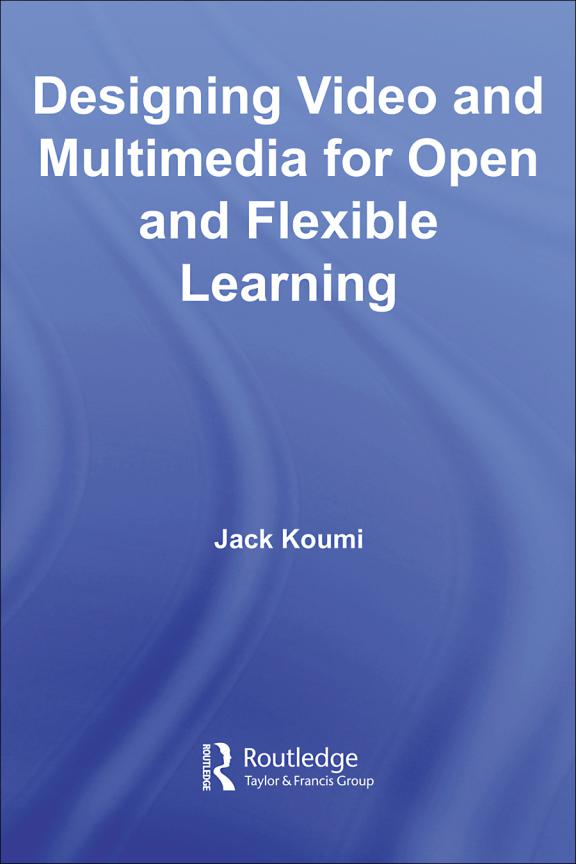
0229836_9011C_jack_koumi_designing_educational_video_and_multimedia_for_op-1
.pdf

D e s i g n i n g V i d e o a n d M u l t i m e d i a f o r O p e n a n d F l e x i b l e L e a r n i n g
In recent years there has been a resurgence in the use of video in teaching and training contexts, due to technological advances that enable good quality moving pictures through CD-Rom, DVD and broadband Internet. This book offers advice and assistance to a growing group of teachers and trainers, technical and support staff in the most effective deployment of video and multimedia in open and distance learning.
A bridge between research and practice, Designing Video and Multimedia for Open and Flexible Learning discusses:
•what to teach on video and how to teach it;
•when to choose and how to use other media for teaching;
•a framework of pedagogic design principles for video and multimedia;
•practical development advice for interactive multimedia.
With insights into the comprehensive process of designing, developing and managing distance learning materials, this book will appeal to readers with varying interests and responsibilities, including course development, educational video, audiovision and interactive multimedia design, as well as to students of general video and multimedia production.
Jack Koumi is a freelance consultant and trainer in the scripting and production of education media. He has conducted over 50 training projects in educational media in 20 countries. Previously, he worked for 22 years at the BBC Open University Production Centre, producing audio and video programmes in Science and Mathematics.

D e s i g n i n g V i d e o a n d M u l t i m e d i a f o r O p e n a n d F l e x i b l e L e a r n i n g
Jack Koumi
First published 2006 by Routledge
2 Park Square, Milton Park, Abingdon, Oxon OX14 4RN
Simultaneously published in the USA and Canada by Routledge
270 Madison Ave, New York, NY 10016
Routledge is an imprint of the Taylor & Francis Group, an informa business
© 2006 Jack Koumi
This edition published in the Taylor & Franchis e-Library, 2006.
“To purchase your own copy of this or any of Taylor & Francis or Routledge’s collection of thousands of eBooks please go to www.eBookstore.tandf.co.uk.”
All rights reserved. No part of this book may be reprinted or reproduced or utilised in any form or by any electronic, mechanical, or other means, now known or hereafter invented, including photocopying and recording, or in any information storage or retrieval system, without permission in writing from the publishers.
British Library Cataloguing in Publication Data
A catalogue record for this book is available from the British Library
Library of Congress Cataloging-in-Publication Data
A catalog record for this book has been requested
ISBN10: 0–415–38304–8 (hbk)
ISBN10: 0–415–38303–x (pbk)
ISBN13: 978–0–415–38304–2 (hbk)
ISBN13: 978–0–415–38303–5 (pbk)

C o n t e n t s
List of figures |
vii |
List of tables |
ix |
Acknowledgements |
xi |
Series editor’s foreword |
xii |
Study guide – how you might use this book |
xiv |
PART I |
|
Techniques and teaching functions that |
|
exploit video’s strengths, adding pedagogic |
|
value |
1 |
Introduction: the added-value categories |
3 |
1 Video that adds cognitive value or skills value: domain 1 of |
|
Table 0.1; distinctive ways to help learning and skills |
7 |
2 Video that adds experiential value: domain 2 of Table 0.1; |
|
providing vicarious experiences |
34 |
3 Video that adds nurturing value: domain 3 of Table 0.1; |
|
nurturing motivations, feelings |
46 |
PART II |
|
Media selection and deployment |
55 |
4 Matching media attributes to learning tasks and teaching |
|
functions |
57 |
vi |
Contents |
|
PART III |
|
|
Pedagogic screenwriting principles for video |
93 |
|
5 |
Screenwriting for video in educational multimedia: an |
|
|
overview of the pedagogic screenwriting principles |
95 |
6 |
Screenwriting for video in educational multimedia: in-depth |
|
|
coverage of the principles of Table 5.3 |
133 |
PART IV |
|
|
Picture – word synergy for audiovision and |
|
|
multimedia |
179 |
|
7 |
Principles of picture–word synergy for audiovision |
181 |
8 |
Screenwriting principles for a multimedia package: |
|
|
picture–word synergy for multimedia with audio commentary |
194 |
|
Appendix 1 |
221 |
|
Appendix 2 |
223 |
|
References |
224 |
|
Index |
229 |

F i g u r e s
1.1 |
Screen inserts: child plus picture |
8 |
1.2 |
(A) Somatic radiation effect, (B) heredity radiation effect |
9 |
1.3 |
Chroma-key |
9 |
1.4(A) The mathematical surface: Klein bottle with disc removed,
|
(B) initial distortion, (C) further distortion, (D) final distortion |
11 |
1.5 |
Varied histograms, all with the same mode |
11 |
1.6 |
(A) Human throat, (B) narrowing when breathing in |
12 |
1.7(A) Mine ceiling collapsed intentionally, (B) if collapse is
prevented, a more dangerous collapse results |
12 |
1.8(A) Pressure cuff technique, (B) Artist’s impression, inside the
arm |
13 |
1.9(A) Breathing in, throat narrows, thorax widens, (B) Breathing
|
out, throat widens, thorax narrows |
14 |
1.10 |
(A) Construction of a bronze-age axe, (B) next stage of the |
|
|
construction, (C) final stage of construction |
15 |
1.11 |
Do students learn from animations or are they merely entertained? |
16 |
1.12 |
Pressure portrayed by vibrating arrows |
16 |
1.13 |
A car thief appears from nowhere |
17 |
1.14 |
(A) Original graph, (B) going back to an earlier time, |
|
|
(C) result of intervention at the earlier time |
17 |
1.15 |
(A) Sucking on a collapsed drinking straw: analogy for difficulty |
|
|
breathing in, (B) no difficulty breathing out |
18 |
1.16 |
A homunculus illustrates differential sensitivity in different parts |
|
|
of the body |
18 |
1.17 |
Back hand rub: aural |
19 |
1.18 |
Metaphor for variability of data |
20 |
1.19(A) Equal angles made by lines through each focus of an ellipse,
(B) each beam of light through a focus is reflected to pass through
the second focus |
21 |
1.20 (A) Biased darts, poor player, (B) biased darts, good player, |
|
(C) balanced darts, poor player, (D) balanced darts, good player |
22 |

viiiList of figures
1.21(A) Axe being covered with sand: first 7 of 35 seconds, (B) cutaway of man’s face (3 seconds), (C) Final 7 seconds of the 35
second activity |
23 |
1.22 (A) Strking plate channel chiselled out, (B) striking plate |
|
positioned, (C) close-up of fitted striking plate |
24 |
1.23(A) Blood pressure reading: pregnant woman, (B) blood pressure reading: old person in hospital, (C) blood pressure reading: in a
|
surgery |
25 |
1.24 |
Blood pressure reading |
26 |
1.25 |
(A) Reassuring doctor, (B) intimidating doctor |
27 |
1.26 |
Narrative sequence |
28 |
1.27 |
Student learning from Audiovision |
29 |
1.28 |
BCU of anastomosis |
30 |
1.29 |
(A) Ice skater, arms wide, (B) close arms to quicken spin |
30 |
1.30 |
Bereavement counselling |
31 |
1.31 |
ICT in the Primary classroom |
32 |
1.32 |
ICT in the Secondary classroom |
33 |
2.1 |
Semi-molten metal, sliced and distorted |
34 |
2.2 |
Bore-hole drill with rotating teeth |
35 |
2.3 |
Control mechanism, balancing a ruler |
35 |
2.4 |
Molten metal in a foundry |
36 |
2.5 |
BCU molten metal poured into a mould |
38 |
2.6 |
Rotating ore sample |
38 |
2.7(A) Assembling a stool: two men not following instructions
correctly, (B) The bored assembler, speeded up |
42 |
3.1 Richard Feyneman, a charismatic teacher |
49 |
3.2(A) Start of the solution to join up the dots with four straight
|
lines, (B) extend the first line past the three dots, then diagonally |
|
|
down/left, (C) complete by drawing upwards then diagonally |
|
|
down/right |
49 |
4.1 |
Revision of Bloom’s taxonomy |
72 |
4.2 |
Checklist for the three types of video package |
77 |
4.3 |
Learning by interaction with teachers and peers |
86 |
6.1 |
Allow talking space |
156 |
6.2 |
Do not cross the line of action |
157 |
6.3Levels of phenomena and their investigation in the brain and
behavioural sciences |
163 |
6.4 Simplification of the relationships, as shown on the video |
163 |
6.5Alternative classification of elements of Table 5.2: narrative
|
characterization (rather than pedagogic classification) |
176 |
7.1 |
Two pages of frames in landscape format |
187 |
A1.1 |
Revised Bloom’s Taxonomy |
223 |

Ta b l e s
0.1 |
Added value video techniques and teaching functions |
4 |
1.1 |
Categories of skills |
28 |
4.1Comparative merits and distinctive teaching attributes of six
different media: print, TV and radio (broadcast), video and audio |
|
(recordings), audiovision (audio + notes/visuals) |
65 |
4.2 Added value video techniques and teaching functions |
71 |
4.3Summary of teaching functions and learning tasks, for media
other than self-standing, non-stop video/TV or computer |
80 |
4.4 Three-stage scheme for media selection |
89 |
5.1The pedagogic framework of narrative screenwriting principles
(part (a) is expanded in Table 5.2 and part (b) in Table 5.3) |
97 |
5.2 Three usage dimensions |
100 |
5.3A Pedagogic Screenwriting Framework for each chapter of the
|
content narrative |
101 |
5.4 |
Outline of the TV programme, Dominance and Subordinacy |
111 |
5.5 |
Shots 1 to 3 of the TV programme, Dominance and Subordinacy |
112 |
5.6 |
Summary of the varying tempo signals in shots 1, 2, 3 |
113 |
5.7 |
The signals given by the 4 possible tempos |
114 |
5.8 |
Shots 4 to 14 of Dominance and Subordinacy |
115 |
5.9Specifications (values) in the three Usage dimensions for the TV
|
programme Dominance and Subordinacy |
116 |
5.10 |
Video sections, narration that initiates each section and implicitly |
|
|
refers to objectives |
119 |
5.11 |
Illustration of principle 4a: words not duplicating pictures |
125 |
5.12 |
Transcript of an animal behaviour shot: in Dominance and |
|
|
Subordinacy |
126 |
5.13 |
Unnatural word order, to maximize picture–word synergy |
128 |
5.14 |
A more natural word order, but the words do not match the |
|
|
pictures |
129 |
5.15 |
Professional Integrity |
130 |
6.1Broadcast Notes for TV – an important example of complementary
learning (Table 5.2, dimension B) |
135 |
